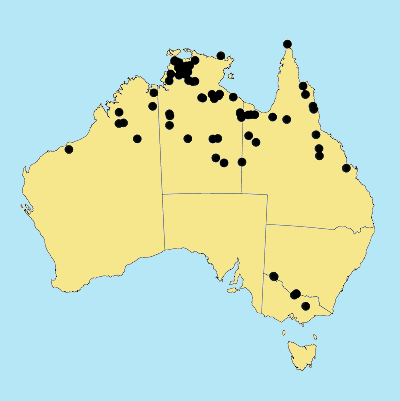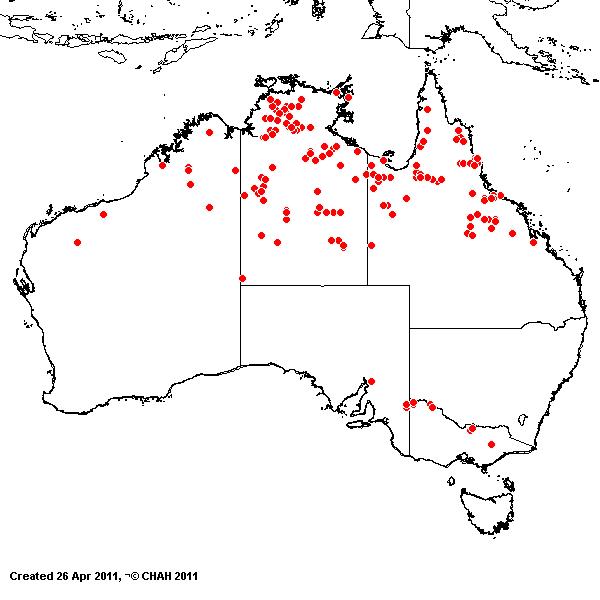Eragrostis exigua M. Lazarides.
Aust. Syst.
Bot. 10: 118
(1997).
Classification. (GPWG 2001) : Subfamily
Chloridoideae. Cynodonteae.
Key references
(books and floras): [2002] D.Sharp & B.K.Simon, AusGrass, Grasses of
Australia,
[2006] J.Jessop, G.R.M.Dashorst, F.M.James, Grasses of South Australia
(370), [2008] S.W.L.Jacobs, R.D.B.Walley & D.J.B.Wheeler, Grasses of New
South Wales (251).
Illustrations:
[2006] J.Jessop, G.R.M.Dashorst, F.M.James, Grasses of South Australia (371, Fig. 300), [2008] S.W.L.Jacobs, R.D.B.Whalley
& D.J.B.Wheeler, Grasses of New South Wales, 4th edn (251).
Habit. Annual.
Culms erect or geniculately ascending or decumbent, stature slender to
delicate, 3–124 cm tall, 1–3 -noded. Lateral branches fastigiate. Ligule an
eciliate membrane or a fringed membrane, a ciliate membrane, 0.3–0.5 mm long,
entire or lacerate. Leaf-blades straight, aciculate or linear or lanceolate,
flat or conduplicate or involute, 2–5 mm wide. Leaf-blade surface scaberulous.
Inflorescence.
Inflorescence compound, a panicle or a panicle. Panicle elliptic, loose, 18–36
cm long, 3–7 cm wide.
Spikelets.
Spikelets pedicelled. Fertile spikelets many flowered, with at least 2 fertile
florets (3–7), comprising 3–7 fertile floret(s), with diminished florets at the
apex, oblong or ovate, laterally compressed, 0.8–2 mm long.
Glumes. Glumes
similar. Lower glume oblong or ovate, membranous, keeled, 1-keeled, 1 -nerved.
Upper glume oblong or ovate, 0.4–0.6 mm long, membranous, keeled, 1-keeled, 1
-nerved. Upper glume surface asperulous.
Florets.
Fertile lemma 0.5–0.7 mm long, keeled, 3 -nerved. Lemma apex muticous. Palea 2 -nerved. Anthers
2. Grain 0.3–0.5 mm long.
Continental
Distribution: Australasia.
Australian
Distribution: Western Australia, Northern Territory, Queensland,
New South Wales, Victoria.
Western Australia: Gardner, Hall,
Dampier. Canning. Northern Territory: Darwin & Gulf, Victoria River,
Barkly Tableland, Central Australia North. Queensland:
Burke, Cook, North Kennedy, Port Curtis, South Kennedy. New South Wales: South-Western
Plains, South Far Western Plains. Victoria:
Riverina.
Notes.
Distinguishing characters include panicle decompound, long relative to plant;
slender annual habit; membranous ligule; small few-flowered spikelet with
vestigial terminal floret; fragile straight rachilla; persistent glumes, lemmas
and paleas; florets falling downwards entire with rachilla internodes; 3-lobed
palea with smooth relatively short keels; two minute terminally exserted
anthers; subulate shining caryopsis.
Endemic;
scattered distribution from Port Hedland, W.A., to about Mackay in E Qld, also
recorded from the the Murray R. area of N Vic. Almost always in seasonally
flooded, alluvial habitats usually with heavy clay or rarely sandy soils (viz.
riverine and estuarine floodplains, black soil plains, sandhill swales, gorge
floors, in or near lagoons, billabongs, swamps, depressions and watercourses).;
flowers Dec., Feb., Mar.-July; fruits Dec., Feb., Mar.-July.




